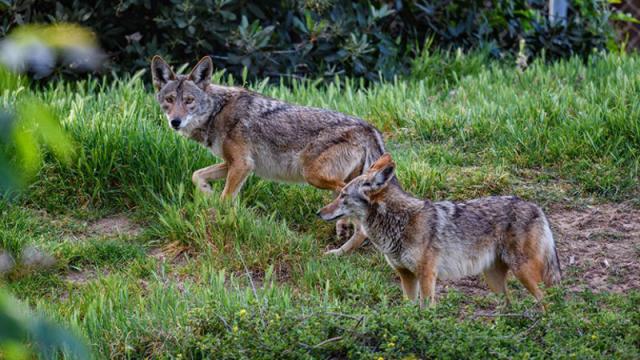A multi-year survey in the Los Angeles metropolitan area shows that nearly two-thirds of an urban coyote’s diet comes from human-related sources—including a surprising amount of cats.
Cities are an unmitigated disaster for most animals, but a select few have found human habitats to be a veritable cornucopia of culinary delights. Raccoons, mice, and rats certainly come to mind, as do coyotes. Indeed, these highly flexible canids, with their penchant for almost any kind of food—whether plant or animal—have found a comfortable niche in virtually every city in North America, and even beyond.
Recent research published in PLOS One shows the startling degree to which urban coyotes, as opposed to their suburban brethren, have turned to human-related sources of food. The new research, a project of the Santa Monica Mountains National Recreation Area (SMMNRA), shows that 65 per cent of an urban coyote’s diet comes from trash, fruiting ornamental plants, and domesticated animals, namely cats. The new paper was co-authored by Justin Brown of the SMMNRA, and researchers from California State University Northridge (CSUN).
By assessing the dietary habits of urban coyotes, urban planners can make better decisions when it comes to managing coyotes. Ultimately, urban officials want to reduce conflicts and uncomfortable encounters involving coyotes and home and business owners.
To that end, the scientists conducted a multi-year survey in which 150 citizen science volunteers collected coyote poop (also known as scat) and whisker samples in the metropolitan Los Angeles area, including Beverly Hills, the San Fernando Valley, Thousand Oaks, Marina del Rey, Baldwin Hills, Westlake Village, Silver Lake, among other neighbourhoods.
In total, the volunteers managed to recover 3,147 coyote poop samples (1,541 from urban sites and 1,606 from suburban sites). So-called “scat parties” were then held, in which the volunteers sifted through the poop, looking for dietary detritus—things like bones, fur, feathers, food wrappers, and so on.
As for the whiskers, they were collected exclusively from coyote carcasses, including recent roadkill. Whiskers were collected because they can be used—thanks to the power of stable isotopes—to identify soft food items that don’t normally present themselves in faecal samples, such as buns and hamburgers. Different plants, for example, express different carbon isotope signatures.
“What we were looking for was corn, which is very distinctive from plants naturally found in Southern California,” said Rachel Larson, a former CSUN graduate student and a co-author of the new study, in a press release. “Corn is the base of the American diet. People eat corn. Corn syrup is used in many processed foods, including bread. Corn is fed to livestock and poultry, which humans, in turn, eat,” said Larson, who is now working on her PhD at the University of Iowa.
Specifically, the researchers were looking for excessive levels of carbon-13, which indicates corn consumption—the source of which can only come from human food, and plenty of it. Analysis of the stable isotopes showed that upwards of 38 per cent of the urban coyote diet comes from foods that humans have thrown away.
“Needless to say,” said Larson, “for those coyotes living in urban Los Angeles, we found they were eating a lot of human food, mostly found in the trash we humans leave behind.”
Of the urban coyote poop samples analysed, 65.2 per cent showed evidence of “anthropogenic items,” while the remaining 34.8 per cent contained evidence of natural food sources, such as wild mammals, invertebrates, birds, reptiles, and native fruits and seeds, according to the research.
Ornamental fruits and seeds, like figs, palm fruits, and grapes, were the most common human-related food, accounting for 26.1 per cent of all poop samples recovered, while 22 per cent of urban scat showed evidence of coyotes sifting through garbage. A whopping 19.8 per cent revealed traces of domesticated cats. Evidence of pet food was scarce at 3 per cent. Even scarcer—at levels below 1.5 per cent—were traces of domesticated dogs, eastern fox squirrels, house mice, domesticated rabbits, and chickens.
[referenced url=” thumb=” title=” excerpt=”]
That cats are a regular fixture of the coyote diet is hardly a surprise, but the number—nearly 20 per cent of urban coyote scat samples—does seem rather high. If it’s any consolation, the authors suspect that the majority of these cats were feral, and not household pets. That said, it’s yet another reminder to keep your cat indoors.
In terms of mammalian food sources of a natural variety, the coyotes liked to feast on pocket gophers, ground squirrels, native mice, and rabbits.
By contrast, only 37 per cent of poop samples from suburban coyotes showed evidence of human-related food items, and only 4 per cent showed signs of consumed cats. In general, suburban coyotes ate less food from human sources than coyotes living in urban environments.
“What this study shows us is that coyotes in Los Angeles’ urban areas are taking advantage of food sources that we don’t secure,” said Brown in a National Parks Service statement. “Whether it’s cats, fruits or garbage, the food resources that we have left out for them is why coyotes hang around. We do have some control over coyotes being here and it’s all tied to us. If we don’t provide the food sources in our neighbourhoods, they would not be living in them.”
An important caveat to this study is that these findings are specific to coyotes living in the metro L.A. area. These numbers are likely to vary elsewhere, owing to a variety of different factors, such as local waste management practices, climate, the availability of natural food sources, and so on. Still, the new study is an eye-opener and a likely indicator of coyotes living in other urban environments.
[referenced url=” thumb=” title=” excerpt=”]
For homeowners who don’t like the idea of coyotes straying too close to their homes, the answer is simple: secure your trash in locked containers, and as previously mentioned, don’t let your cats out. Don’t worry about coyotes not being able to find food sources elsewhere—these cunning critters will be just fine.
